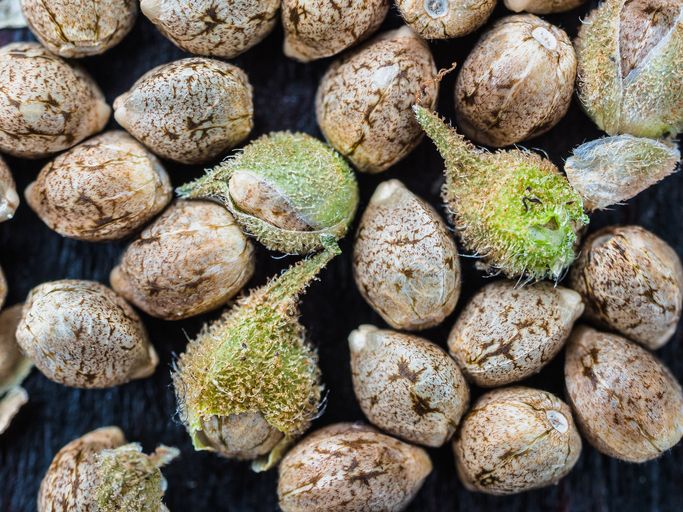The Ultimate Guide to Growing Marijuana Seeds

Growing cannabis is often viewed as a relatively easy task, but few take the time to learn about the most important component, the seeds. Marijuana seeds come in a variety of different types and getting them started isn’t always as easy as you might expect, especially for beginners, but luckily, you’ve got us to help you out. Here you will learn absolutely everything that there is to know about cannabis seeds including quality, germination, storage, and more.
Types of cannabis seeds
Cannabis seeds is a term that is used loosely to describe any of the different seed types below. They can be of any heritage or genetic line, either strain type (Sativa or Indica), and may or may not have any THC or CBD content. It simply describes the kind of plant and not anything about a specific marijuana plant species.
1. Sativa seeds
Sativa seeds will grow a Sativa subspecies of cannabis. Sativa plants offer a wider range of options including both high and low CBD or THC content. The most significant characteristic of this species of marijuana plants is found in the way that they grow and produce flowers. This type tends to become much taller and spindlier than their Indica counterparts, with an average height ranging between 5-7 feet, and smaller more tightly bound buds that tend to provide smaller yields. These cannabis seeds are not often chosen for indoor grow rooms due to their stature but are frequently preferred for their medicinal use as their stereotypical effects are lighter paired with a higher CBD content.
2. Indica seeds
Another subspecies of the cannabis plant is Indica, which are most widely accepted as the most potent of the two type of cannabis due to its stereotypical sedative effects. The most significant quality to remember about Indica seeds is that they will produce shorter, bushier plants with much larger colas. Their average height ranges between 3-4 feet tall making them ideal for many smaller-scale growers who are limited in space. Indica is often considered to be a favorite among recreational users but also can medically assist in cases of chronic pain, depression, or anxiety.
3. Hemp seeds
Hemp seeds are the only kind of cannabis seeds that will not produce a plant that has much, if any THC content, making them of little use to recreational users. Hemp seeds are most often used as an addition to health food, or as a plant material base to extract CBD from in the making of CBD oils and tinctures that won’t get you stoned but are sought after by medicinal patients. Hemp seeds come in two different categories of their own, including regular hemp seeds and industrial hemp seeds. Regular hemp is what is used for medical reasons, where industrial hemp is grown and harvested for its fibrous nature.
What are Feminized Cannabis Seeds?
These seeds are specifically designed to create only female cannabis plants. Feminized seeds are selectively bred among themselves to produce a seed that has a 99% chance of resulting in a female plant. Since females are generally the only type of cannabis plant that anyone wants, these seeds come at a higher cost but also a significant benefit.
Growing regular cannabis seeds will have a 50% chance of resulting in a male or female which often ends up wasting precious space in a grow room, only to have to be destroyed once they show their sex. This is why feminized seeds are considered to be some of the best cannabis seeds that money can buy.
What are Auto-flowering cannabis seeds?
Auto-flowering marijuana seeds can also be any other kind of cannabis seed listed here. They are created, used, and selectively bred for their incredibly short growing season, with many auto-flowering strains going from seed to harvest in as little as 12 weeks.
All about High CBD seeds
CBD seeds are available for the consumer who enjoys Sativa, Indica or hybrid cannabis strains, and for the hemp grower whose objective is to produce a high CBD content in the plant, choosing the perfect seed selection is imperative to providing an upscale, top-shelf health product. Before a plant can produce abundant crops high in CBD, a stable, productive seed is necessary. The using of a questionable seed can lead to failure by the field full and purchasing questionable seeds can lead to the instability of the CBD plants future.
How to tell the quality of cannabis seeds
There is no real way to tell the quality of marijuana seeds unless you know everything about where they were created, and their journey to you, but since most people don’t, it can help to know what to look for. These questions can help you to assess cannabis seeds, based on visual cues and knowledge that you may have about its history.
1. What color is it?
If your marijuana seeds boast darker color patterns with visible veins, then it’s a good indicator that they may be of good quality.
2. How does it look?
Are there any pieces missing from the shell, or large white areas with no color or pattern? If you answered yes to either of those questions, then you probably have a low-quality seed.
3. How does it smell?
The aroma of a cannabis plant is strong and tends to cling to all the materials including the seeds. Marijuana seeds that still smell like the fresh plant are probably fresh which shows that they are likely good enough quality to grow, but it is no indication as to the plant, that will come from the seed.
4. Where did it come from?
If you get marijuana seeds from a friend who just started growing, then they might be good quality seeds, but they probably aren’t going to offer any of the benefits that specialists create in feminized or auto-flowering option, and they will likely only offer a 50% chance of resulting in a female plant.
5. How old is it?
If the cannabis seeds are more than a couple of years old and or stored improperly, then they aren’t going to be of very high quality.
How to germinate marijuana seeds
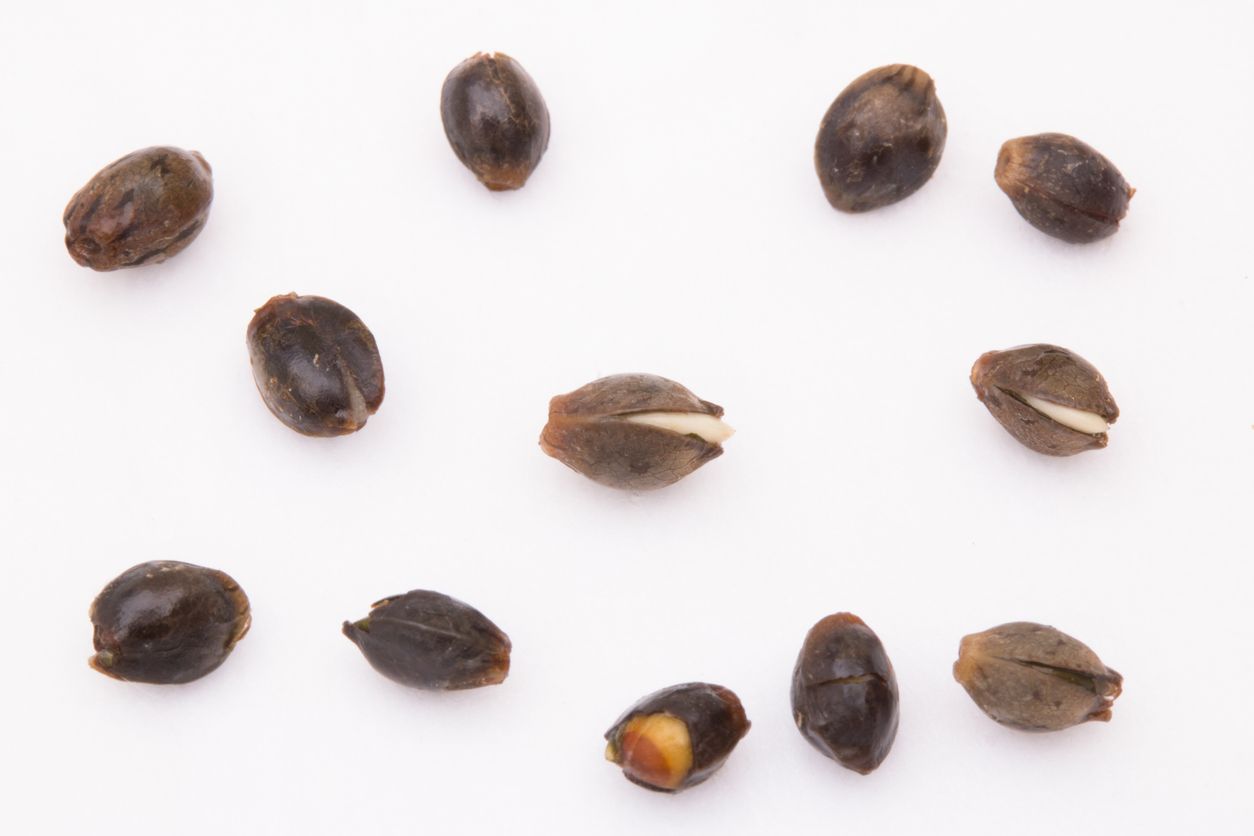
Germinating seeds is easier and less technical than it sounds. What’s important is providing the seed with the optimal conditions to give it the best possible shot at sprouting and becoming a healthy plant. It doesn’t require any special equipment and can likely be done with materials you already have sitting at home. Here we will show you two different methods of germinating cannabis seeds.
1. The Paper towel method
The most widely used by far is the paper towel method. This one will require only 4 things.
- Water
- 2 large sheets of paper towel
- Seeds
- 1 large Ziploc baggie
Instructions
Step 1 - Line 1 side of the Ziploc baggie with one sheet of paper towel. Use room temperature or lukewarm water to dampen the paper towel
Step 2 – Place the seeds with a spacing of at least 1 inch apart evenly across the paper towel
Step 3 - Place the second sheet of paper towel over the top of the seeds, flush with the first.
Step 4 - Use room temperature water to generously moisten the second layer and lift the bag by the corner, so it naturally closes, but do not seal it.
Step 5 - Place in a warm dark spot. It can take anywhere from 2 to 7 days for all the seeds that will sprout to emerge
Step 6 - Once the sprouts are visible, they are ready to be planted
2. The water method
While this one may not be the most popular, it does offer an overall success rate higher than the paper towel method, and some find it easier to separate the sprouts since there is no paper towel to worry about damaging the roots. All that’s required for this one is a glass or jar of lukewarm water and the seeds you are germinating.
Instructions
Step 1- Fill a glass or jar with lukewarm water. Not hot, too much heat will damage the seeds, and you do not want to boil them.
Step 2 - Add seeds to the water
Step 3 - Store in a warm dark place for 2 days
Step 4 - It shouldn’t take any longer for the seeds to germinate than 48 hours
Step 5 - Once sprouts are visible, they are ready to be planted.
How to germinate cannabis seeds that are aged
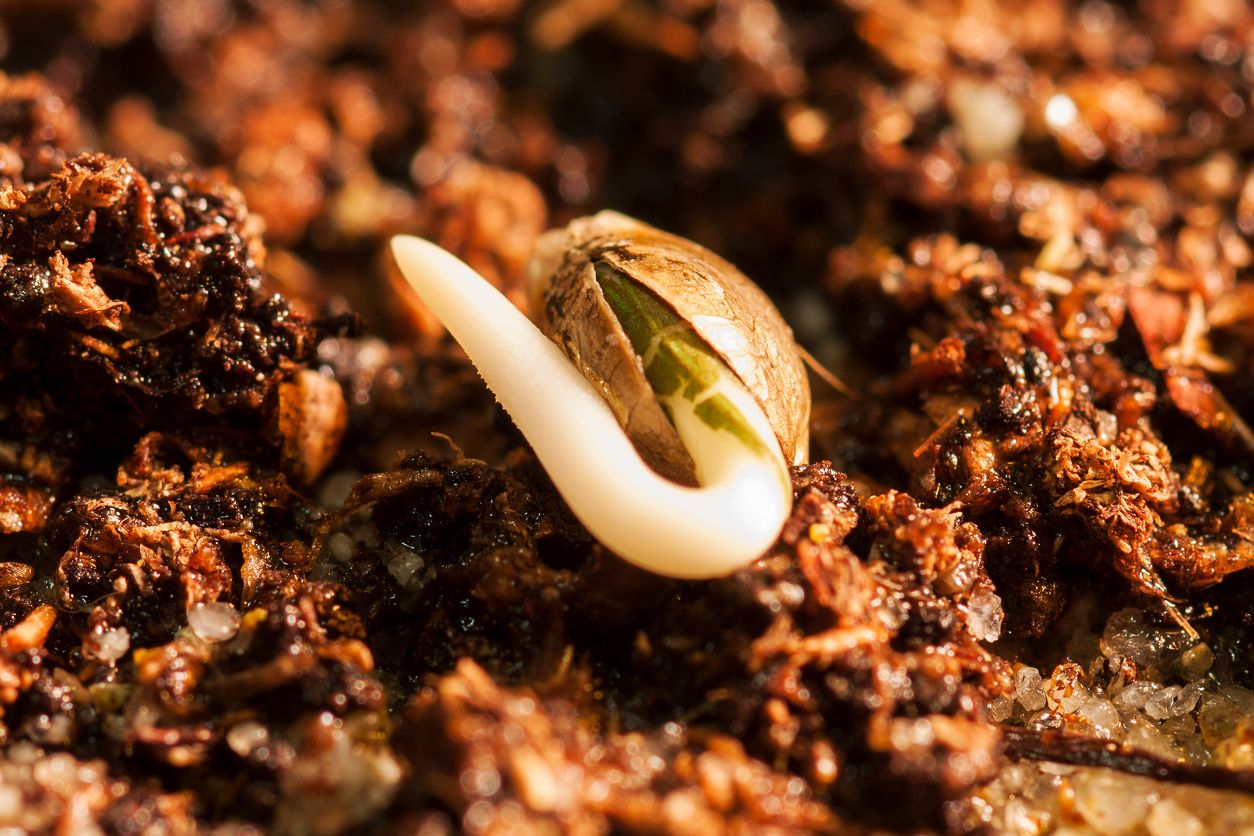
Many growers, both experienced and otherwise, will hold onto seeds that were taken from marijuana strains that they really enjoyed in the past. Those genetics will stay safely preserved for many years while encased in a protective shell, but sometimes time passes and they get misplaced or simply forgotten about and then dug up some time later, only for the person to assume they aren’t any good and throw them out.
The thing is, that even if you are having difficulty germinating old seeds, there are several things you can do to achieve a higher success rate and breathe new life into cannabis seeds that might just need a little bit of extra love and care to get started.
1. Water - soil-free method
If you want to revive your old marijuana strains, then you will need to start with a massive dose of hydration. This can happen one of several ways, but the simplest and most common is a soaking in a glass of water to soften the shell and make it easier for the sprout to escape.
Step 1- Drop the weed seeds into a cup of lukewarm water that is ideally 21°C for 24 hours. Watch out for early openers, and if you see any split before the 24-hour mark, remove them immediately to prevent drowning.
Step 2- After 24 hours, remove the cannabis seeds, and place them on a moistened paper towel.
Step 3- Fold the paper towel in half and place it into a Ziploc baggie in a warm room.
2. Fulvic Acid - soil starting method
Not everyone feels comfortable with starting their precious cannabis seeds in water, and for them, there are other options like fulvic acid that can be added after the seed is planted directly into the soil.
Step 1- Plant the seed approximately 1 inch deep.
Step 2- Combine 1 liter of water with 10 milliliters of fulvic acid.
Step 3- Use the mixture to water the soil that the weed seeds are planted in.
3. Carbonated water - soil starting method
Another soil germinating option that works great with aged cannabis seeds is carbonated water.
Step 1- Plant the seeds with spaces at least 1 foot apart and one inch deep.
Step 2- Combine 1 cup of carbonated water with 1 liter of regular water.
Step 3- Moisten the soil that surrounds the weed seeds that have been planted.
4. Germination enhancer - soil starting method
There are specially designed germination enhancers that are edible plant safe and can be used for marijuana strains, and each one will require a different amount of preparation and application. For the best success, it is always recommended that you invest in a cannabis-specific product to avoid unnecessary toxins or other complications.
5. Storage
The most important part of having weed seeds that still sprout nearly 10 years later is mainly in how they are stored. If you are just coming across some old cannabis seeds, then this advice isn’t overly helpful, but if you store them in a sealed, dry, cool space, they can protect the genetics of your favorite marijuana strains for almost an entire decade. Giving you plenty of time to decide when you’d like to grow them.
6. Last ditch effort - sanding
If all else fails, and you have nothing to lose anyway, then there is the risky option of sanding away at the shell to thin it. This is often enough to provide a small boost for sprouts to escape but is rarely recommended as it can damage the integrity of the entire seed if done wrong. If you do decide to try it, make sure that you don’t remove any more than the surface colors before using one the moisture techniques above.
How long does it take to germinate weed seeds?
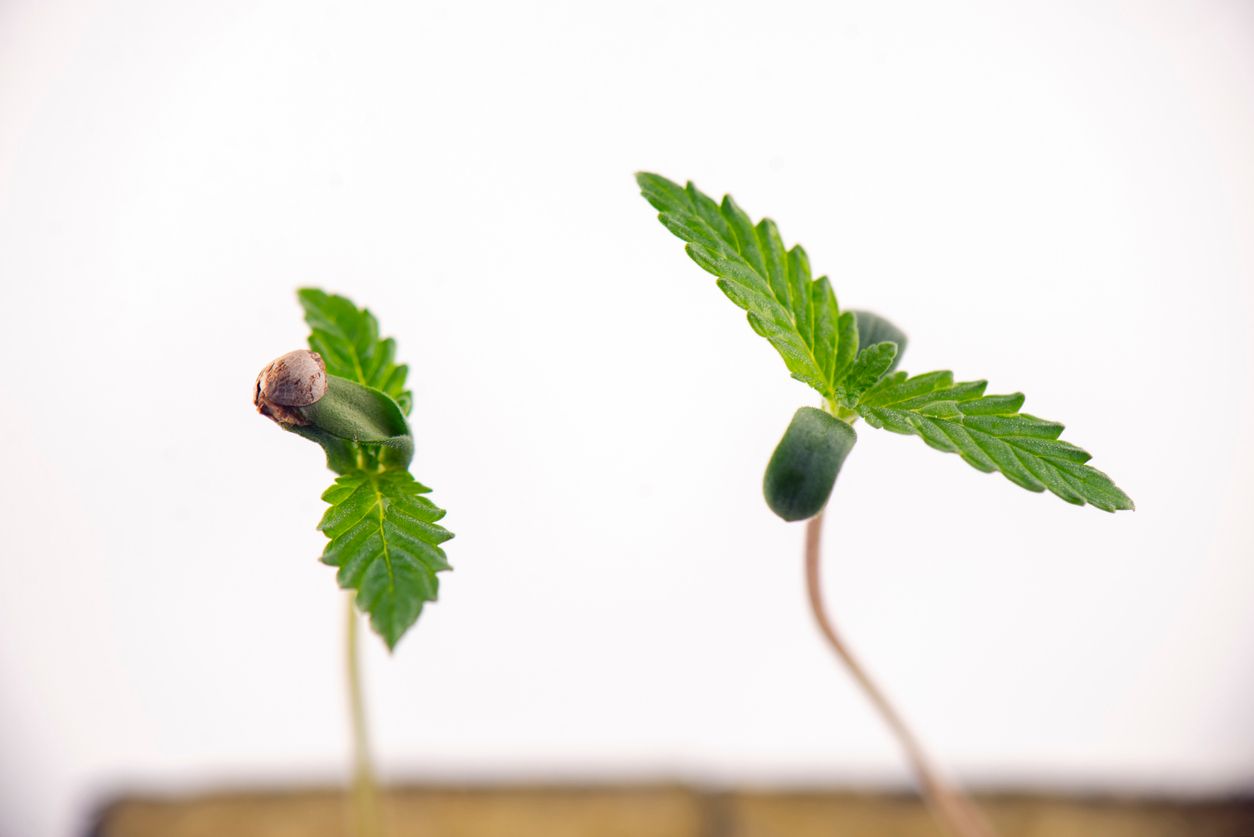
Fresh marijuana seeds will sprout faster than their aged counterpart and with them, you might notice a sprout appear within only a few days, but the average time you can expect it to take for germination is between 3 and 10 days.
When to plant germinated cannabis seeds
Germination can take a bit of time to complete and your fresh cannabis sprouts won’t be ready for the soil until you’ve seen that at least one or two small fan leaves have developed. That also helps to guide you in the plating process so that you know which direction the shoot is trying to go.
How to plant cannabis sprouts
Transplanting cannabis seedlings that were started in pucks or pellets are the easiest. Just dig a hole into whatever growing medium you are using that is a tiny bit bigger than the inflated puck and bury the very base of the plant to cover the entire top of the casing. If you are using pots instead, you will need to release them from the containers gently. Usually, a gentle squeeze from a couple of different directions is enough to loosen the soil. If you find that alone is not working, you can add water which will soften the substrate. Once it is free, dig a hole that is a little bit bigger than the original pot and plant it in the center of a new large one. 2 gallons or larger are most recommended as destination pots for marijuana plants.
How to store marijuana seeds
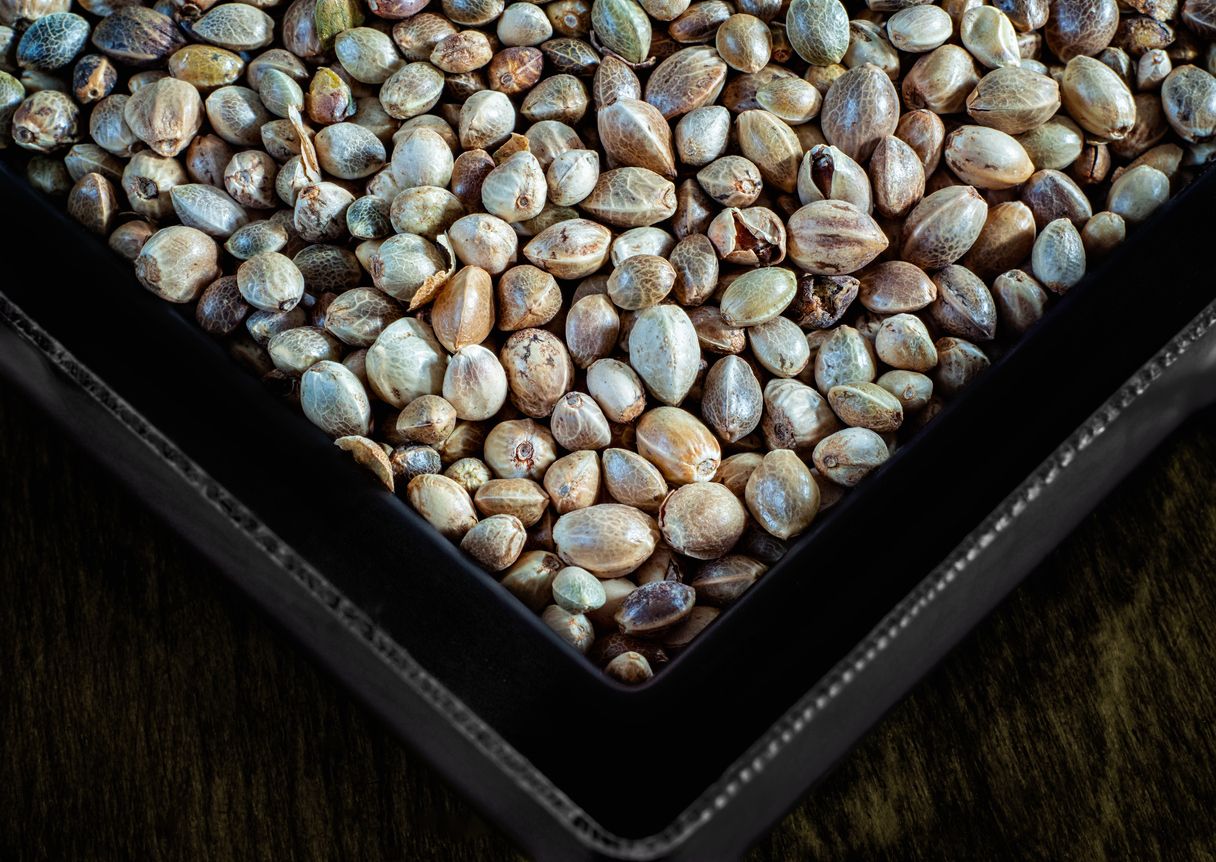
To best preserve cannabis seeds, you will need to store them in a dark, cool, and dry area. These babies may be dormant, but they are still very much alive and need to be treated with the utmost care. Marijuana seeds will deteriorate quickly when exposed to heat, humidity, dramatic temperature drops, or rough handling, so storage in a fitting or soft-lined container in a cool (not cold) dark space is ideal.
How long will marijuana seeds last in storage?
It is always best to use your marijuana seeds within a couple of years of obtaining them, as even if they are stored perfectly, age will slowly harden the shell and make them more difficult to germinate. However, a good quality cannabis seed stored under the right conditions can last more than 10 years, and still be viable, so don’t be too quick to toss your stash just because it’s been kicking around for a while. You can also store them in the freezer but going that far isn’t typically needed if you follow the tips laid out here.
Cannabis seeds vs cannabis clones
Cannabis clones do offer several benefits that seeds just cannot provide, like skipping right over germination and the plants staying smaller and more manageable, but they also cost a whole lot more while remaining nearly impossible to find from a legal vendor. Marijuana seeds are cost-effective, resulting in the strongest root systems, and don’t take much to get sprouted, so they are often the preferred choice for both beginner and expert level growers.
Cost of cannabis seeds
There are so many things that can influence the price of a marijuana seed, that there is no way to provide an average across the board. Those that require a stricter, more in-depth process like feminized or auto-flowering seeds, can cost hundreds of dollars each if they are from a popular strain, but there are much more budget-friendly options as well with some selling for as little as $10 each.
Where to buy cannabis seeds
Right now, the rules and regulations surrounding the sale of marijuana seeds restrict the average person from selling them privately, so the safest way to buy them is directly through your local government-regulated cannabis dispensary, by visiting them in person, or online.
The legality of cannabis seeds
Only federally and provincially approved vendors are legally allowed to sell cannabis seeds, so it is important to research a provider thoroughly before placing an order. That means your options are relatively limited for buying, but marijuana seeds can be traded or gifted legally, so a great alternative option is to join a seed exchange program where you can connect with other like-minded individuals and legally trade products.


